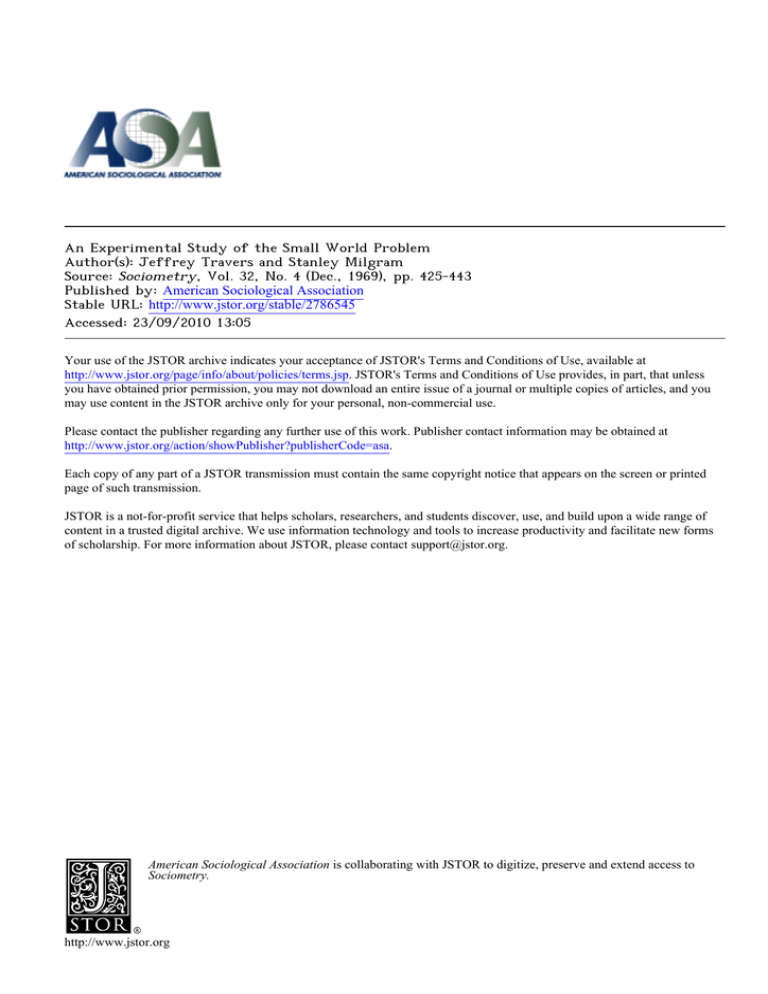An Experimental Study of the Small World Problem
advertisement

An Experimental Study of the Small World Problem Author(s): Jeffrey Travers and Stanley Milgram Source: Sociometry, Vol. 32, No. 4 (Dec., 1969), pp. 425-443 Published by: American Sociological Association Stable URL: http://www.jstor.org/stable/2786545 Accessed: 23/09/2010 13:05 Your use of the JSTOR archive indicates your acceptance of JSTOR's Terms and Conditions of Use, available at http://www.jstor.org/page/info/about/policies/terms.jsp. JSTOR's Terms and Conditions of Use provides, in part, that unless you have obtained prior permission, you may not download an entire issue of a journal or multiple copies of articles, and you may use content in the JSTOR archive only for your personal, non-commercial use. Please contact the publisher regarding any further use of this work. Publisher contact information may be obtained at http://www.jstor.org/action/showPublisher?publisherCode=asa. Each copy of any part of a JSTOR transmission must contain the same copyright notice that appears on the screen or printed page of such transmission. JSTOR is a not-for-profit service that helps scholars, researchers, and students discover, use, and build upon a wide range of content in a trusted digital archive. We use information technology and tools to increase productivity and facilitate new forms of scholarship. For more information about JSTOR, please contact support@jstor.org. American Sociological Association is collaborating with JSTOR to digitize, preserve and extend access to Sociometry. http://www.jstor.org An ExperimentalStudy of the Small World Problem* JEFFREY TRAVERS Harvard University AND STANLEY MILGRAM The City Universityof New York selectedindividuals(N-296) in Nebraskaand Bostonare asked Arbitrarily to generateacquaintancechainsto a targetpersonin Massachusetts,employing "the small world method" (Milgram, 1967). Sixty-fourchains reach bethe targetperson.Withinthisgroupthe mean numberof intermediaries the tweenstartersand targetsis 5.2. Boston startingchains reach target thanthosestartingin Nebraska; subpopulapersonwithfewerintermediaries tionsin the Nebraskagroupdo not differamongthemselves.The funneling of chainsthroughsociometric "stars"is noted,with48 per centof the chains passingthroughthreepersonsbeforereachingthe target.Applicationsof the methodto studiesof large scale social structure are discussed. the smallworldproblemis "what is the The simplestway of formulating froma largepopulation, probabilitythatany twopeople,selectedarbitrarily suchas thatof theUnitedStates,willknoweach other?"A moreinteresting formulation, however,takes accountof the fact that,whilepersonsa and z may not know each other directly,they may share one or more mutual acquaintances;that is, theremay exista set of individuals,B, (consisting of individualsbi, b2 . . . bn) who knowboth a and z and thus link them a and z may be connectednot by any single to one another.More generally, commonacquaintance,but by a seriesof suchintermediaries, a-b-c-. . . -y-z; i.e., a knowsb (and no one else in the chain); b knowsa and in addition knowsc, c in turnknowsd, etc. To elaboratethe problemsomewhatfurther, let us representthe popula* The study was carriedout while both authors were at Harvard University,and was financedby grants from the Milton Fund and from the Harvard Laboratory of Social Relations.Mr. JosephGerverprovidedinvaluable assistancein summarizingand criticizing the mathematicalwork discussedin thispaper. 425 426 SOCIOMETRY tion of the United States by a partiallyconnectedset of points.Let each pointrepresenta person,and let a line connectingtwo pointssignifythat the twoindividualsknoweach other.(Knowingis hereassumedto be symmetric:if a knowsb thenb knowsa. Substantively, "knowing"is used to denotea mutualrelationship;othersenses of the verb,e.g. knowingabout a famousperson,are excluded.) The structuretakes the formof a cluster of roughly200 millionpoints with a complexweb of connectionsamong them.The acquaintancechains describedabove appear as pathwaysalong connectedline segments.Unless some portionof the populationis totally isolated fromthe rest,such that no one in that subgroupknows anyone outsideit, theremustbe at least one chainconnecting any twopeoplein the population.In generaltherewill be manysuch pathways,of variouslengths, betweenany two individuals. In view of such a structure,one way of refiningour statementof the smallworldproblemis thefollowing:giventwoindividualsselectedrandomly fromthe population,what is the probabilitythat the minimumnumberof intermediariesrequired to link them is 0, 1, 2, . . . k? (Alternatively,one mightask not about the minimumchains betweenpairs of people, but mean chain lengths,median chain lengths,etc.) Perhapsthe most directway of attackingthe small worldproblemis to tracea numberof real acquaintancechainsin a largepopulation.This is the techniqueof the study reportedin this paper. The phrase "small world" suggeststhatsocial networksare in some sense tightlywoven,fullof unexpected strandslinkingindividualsseeminglyfar removedfromone another in physicalor social space. The principalquestionof the presentinvestigacould be demonstrated tion was whethersuch interconnectedness experimentally. The only exampleof mathematicaltreatmentdealing directlywith the small world problemis the model providedby Ithiel Pool and Manfred Kochen (unpublishedmanuscript).Pool and Kochen assume a population of N individuals,each of whom knows,on the average,n othersin the population.They attemptto calculatePk, the probabilitythat two persons fromthegroupcan be linkedby a chainof k intermediaries. chosenrandomly Theirbasic modeltakesthe formof a "tree"or geometric progression. Using an estimateof averageacquaintancevolumeprovidedby Gurevitch(1961), will be requiredto link typicalpairs of theydeducethattwo intermediaries individualsin a populationof 200 million.Theirmodeldoes not take account of social structure.Instead of allowingacquaintance nets to definethe boundariesof functioning social groups,Pool and Kochenmust,forthepurposes of theirmodel,conceiveof societyas beingpartitionedinto a number of hypothetical groups,each withidenticalpopulations.They are thenable STUDY OF THE SMALL WORLD PROBLEM 427 to devisea way to predictchainlengthswithinand betweensuchhypothesized groups. In an empiricalstudyrelatedto the small worldproblemRapoportand Horvath (1961) examinedsociometric nets in a junior high school of 861 students.The authorsasked studentsto name in order their eight best friendswithinthe school.They thentracedthe acquaintancechains created i.e. the by the students'choices. Rapoportwas interestedin connectivity, fractionof the total populationthat would be contactedby tracingfriendship choices froman arbitrarystartingpopulation of nine individuals. Rapoportand his associates (Rapoport and Horvath, 1961; Foster et al., 1963; Rapoport, 1953; 1963) have developed a mathematicalmodel to describethis tracingprocedure.The model takes as a point of departure randomnets constructed in the following manner:a smallnumberof points is chosenfroma largerpopulationand a fixednumberof "axones" is extendedfromeach of thesepointsto a set of targetpointschosenat random fromthepopulation.The same fixednumberof axonesis thenextendedfrom each of the targetpoints to a set of second generationtargetpoints,and the process is repeatedindefinitely. A targetpoint is said to be of the tthremoveif it is of the tthgenerationand no lowergeneration.Rapoport thensuggestsa formulafor calculatingthe fraction,Pt, of the population pointswhichare targetsof the tth remove.He is also able to extendthe formulato nonrandomnets, such as those created in the Rapoport and Horvath empiricalstudy,by introducinga numberof "biases" into the randomnetmodel.Rapoportshowsthattwoparameters, obtainablefromthe data, are sufficient to producea closefitbetweenthepredictions of themodel and the empiricaloutcomeof the traceprocedure.1 Rapoport'smodel was designedto describea trace procedurequite differentfromthe one employedin the presentstudy; however,it has some relationto the small worldproblem.If we set the numberof axones traced froma givenindividualequal to the total numberof acquaintancesof an average person, the Rapoport model predicts the total fractionof the populationpotentiallytraceable at each remove fromthe start, serving preciselythe aims of the modelof Pool and Kochen. (It should,however, be noted that Rapoport'smodel deals with asymmetric nets, and it would to modifythe modelto deal withgeneralsymmetric be difficult nets,which characterizethe small worldphenomenon.) Despite the goodnessof fitbetweenRapoport'smodeland the data from 1 Thereis additionalempirical evidence(Fararo and Sunshine,1964) and theoretical to describe are sufficient thattwoparameters support(Abelson,1967) fortheassumption on i.e. thatmorecomplexbiaseshave minimaleffects the Rapoporttracingprocedure, nets. in friendship connectivity 428 SOCIOMETRY two large sociograms,there are unsolved problems in the model, as Rapoporthimselfand others (Fararo and Sunshine,1964) have pointed for an empiriout. The Pool-Kochenmodel involvesassumptionsdifficult cally orientedsocial scientistto accept,such as the assumptionthat society may be partitionedinto a set of groupsalike in size and in internaland to In the absence of empiricaldata, it is difficult externalconnectedness. On the other knowwhichsimplifying assumptionsare likelyto be fruitful. hand, with regardto the empiricalstudy of Rapoport and Horvath,the and homofact that the total populationemployedwas small,well-defined, geneousleaves open manyquestionsabout the natureof acquaintancenets in thelargersociety.2An empiricalstudyof Americansocietyas a wholemay well uncoverphenomenaof interestboth in theirown rightand as constraintson the natureof any correctmathematicalmodel of the structure of large-scaleacquaintanceshipnets. PROCEDURE This paper followsthe procedurefortracingacquaintancechains devised and firsttestedby Milgram (1967). The presentpaper introducesan experimentalvariationin this procedure,by varying"startingpopulations"; it also constitutesa firsttechnicalreporton the small worldmethod. The proceduremaybe summarized as follows:an arbitrary "targetperson" and a groupof "startingpersons"wereselected,and an attemptwas made to generatean acquaintancechain fromeach starterto the target.Each starterwas providedwitha documentand asked to beginmovingit by mail towardthe targetThe documentdescribedthe study,named the target,and asked the recipientto becomea participantby sendingthe documenton. It was stipulatedthat the documentcould be sent only to a first-name acquaintanceof the sender.The senderwas urged to choose the recipient in sucha way as to advancetheprogressof the documenttowardthe target; severalitemsof information about the targetwere providedto guide each new senderin his choice of recipient.Thus, each documentmade its way along an acquaintancechain of indefinite length,a chain whichwould end only whenit reachedthe targetor when someonealong the way declined to participate.Certainbasic information, such as age, sex and occupation, was collectedforeach participant. 2 In additionto thePool-Kochen and Rapoportwork,thereare numerous otherstudies of socialnetwork phenomena relatedto thesmall-world tangentially problem.Two wellknownexamplesare Bailey'sThe Mathematical Theoryof Epidemicsand Coleman,Katz and Menzel'sMedicalInnovation.Bailey'sworkdeals withdiffusion froma structured source,ratherthanwithconvergence on a targetfroma set of scatteredsources,as in thepresentstudy.The Coleman,Katz and Menzelstudydeals withan important substantivecorrelateof acquaintance nets,namelyinformation diffusion. STUDY OF THE SMALL WORLD PROBLEM 429 We wereinterested in discovering some of the internalstructuralfeatures of chains and in makingcomparisonsacross chains as well. Among the questionswe hoped to answerwerethe following:How manyof the starters -if any-would be able to establishcontact with the targetthrougha chain of acquaintances?How many intermediaries would be requiredto link the ends of the chains? What formwould the distribution of chain lengthstake? What degreeof homogeneity in age, sex,occupation,and other characteristics of participants wouldbe observedwithinchains?How would completechainsdifferfromincompleteon theseand otherdimensions? An additionalcomparisonwas set up by using three distinctstarting subpopulations.The targetpersonwas a Boston stockbroker;two of the startingpopulationswere geographically removedfromhim, selectedfrom the state of Nebraska. A thirdpopulationwas selected fromthe Boston while area. One of the Nebraska groupsconsistedof bluechipstockholders, the secondNebraskagroupand the Bostongroupwere"randomly"selected and had no specialaccess to the investment business.By comparisons across thesegroupswe hoped to assess the relativeeffectsof geographicaldistance and of contactwith the target'soccupationalgroup. Moreoverwe hoped to establisha strategyforfutureexperimental extensionsof the procedure, in whichthesociologicalcharacteristics of thestartingand targetpopulations wouldbe systematically variedin orderto exposefeaturesof social structure. The primaryresearchquestions,then,involveda test of the feasibility and fruitfulness of the methodas well as an attemptto discoversome elementaryfeaturesof real social nets. Several experimental extensionsof the procedureare alreadyunderway.A moredetaileddescriptionof the current methodis givenin the following sections. StartingPopulation.The startingpopulationforthe study PARTIcIPANTS. was comprisedof 296 volunteers.Of these,196 were residentsof the state of Nebraska,solicitedby mail. Withinthis group,100 were systematically chosen ownersof blue-chipstocks; these will be designated"Nebraska stockholders" thispaper. The restwerechosenfromthe populathroughout tionat large; thesewill be termedthe "Nebraska random"group.In addition to the two Nebraska groups,100 volunteerswere solicitedthroughan in a Boston newspaper(the "Boston random"group). Each advertisement memberof the startingpopulationbecame the firstlink in a chain of acquaintancesdirectedat the targetperson. Intermediaries. The remainingparticipantsin the study,who numbered 453 in all, werein effectsolicitedby otherparticipants;theywereacquaintancesselectedby previousparticipantsas people likelyto extendthe chain towardthe target.Participationwas voluntary.Participantswerenot paid, norwas moneyor otherrewardoffered as incentiveforcompletion of chains. 430 SOCIOMETRY THE DOCUMENT.The 296 initialvolunteersweresent a documentwhich was the-principaltool of the investigations The documentcontained: a. a description of thestudy,a requestthatthe recipientbecomea participant,and a set of rules forparticipation; him; concerning b. thenameof the targetpersonand selectedinformation c. a roster,to whicheach participantwas asked to affixhis name; about each d. a stack of fifteenbusinessreplycards asking information participant. Rules for Participation.The documentcontainedthe followingspecific instructions to participants: a. Add yourname to the rosterso thatthe nextpersonwho receivesthis folderwill knowwhomit came from. b. Detach one postcardfromthe bottomof this folder.Fill it out and returnit to Harvard University.No stamp is needed. The postcard is veryimportant.It allows us to keep track of the progressof the folderas it movestowardthe targetperson. c. If you know the targetperson on a personalbasis, mail this folder directlyto him (her). Do this only if you have previouslymet the targetpersonand know each otheron a firstname basis. d. If you do not know the targetperson on a personalbasis, do not try to contacthim directly.Instead, mail this folderto a personal acquaintancewho is morelikelythan you to know the targetperson. You may send thebookleton to a friend,relative,or acquaintance,but it mustbe someoneyou knowpersonally. who lives in Sharon, TargetPerson.The targetpersonwas a stockholder Massachusetts,a suburbof Boston, and who worksin Boston proper.In particadditionto his name,address,occupationand place of employment, ipants were told his college and year of graduation,his militaryservice dates, and his wife'smaidenname and hometown.One questionunderinwhichpeople would use in reaching was the typeof information vestigation the target. Roster.The primaryfunctionof the rosterwas to prevent"looping,"i.e., to preventpeople fromsendingthe documentto someonewho had already receivedit and sentit on. An additionalfunctionof the rosterwas to motivate people to continuethe chains.It was hoped thata list of priorparticipants,includinga personalacquaintancewho had sent the documentto of this experimental documentappearsin Milgram, A photographic reproduction 1969: 110-11. STUDY OF THE SMALL WORLD PROBLEM 431 therecipient, wouldcreatewillingness on the part of thosewho receivedthe documentto send it on. TracerCards. Each participantwas asked to returnto us a businessreply cardgivingcertaininformation about himselfand about thepersonto whom he sent the document.The name, address,age sex and occupationof the senderand sender'sspouse were requested,as were the name, address,sex and age of the recipient.In addition,the natureof the relationship between senderand recipient-whetherthey were friends,relatives,businessassociates, etc.-was asked. Finally, participantswere asked why they had selectedtheparticularrecipientof the folder. The businessreplycardsenabledus to keep runningtrackof theprogress of each chain. Moreover,theyassuredus of gettinginformation even from chainswhichwerenot completed,allowingus to make comparisons between completeand incompletechains. RESULTS COMPLETIONS.217 of the 296 startingpersonsactuallysent the document on to friends.Anyone of the documentscould reach the targetpersononly if thefollowing weremet: 1) recipients weresufficiently motivated conditions to send the documenton to thenextlink in the chain; 2) participants were able to adopt some strategyformovingthe documentscloserto the target allow themto (this conditionfurtherrequiredthat the given information selectthe nextrecipientin a mannerthat increasedthe probabilityof contactingthe target); 3) relativelyshortpaths were in fact requiredto link startersand target(otherwisefewchainswould remainactive long enough therewas serious doubt to reach completion).Given these contingencies, whetherany of the documents, in the mindof the investigators particularly thosestartingin an area remotefromthe targetperson,could movethrough interlocking acquaintancenetworksand convergeon him. The actual outcomewas that64 of the folders,or 29 per centof thosesentout by starting persons,eventuallyreachedthe target. DISTRIBUTIONOF CHAIN LENGTHS. CompleteChains. Figure 1 showsthe frequency distribution of lengths of the completed chains. "Chain length" is heredefinedas thenumberof intermediaries requiredto link startersand is 5.2 links. target.The mean of the distribution It was unclearon firstinspectionwhetherthe apparentdrop in frequency at the medianlengthof fivelinkswas a statisticalaccident,or whetherthe was actually bimodal. Furtherinvestigation revealed that the distribution summaryrelationgraphedin Figure 1 concealedtwo underlyingdistributions: whenthe completedchainsweredividedinto thosewhichapproached the target throughhis hometownand those which approachedhim via SOCIOMETRY 432 20 - 15 - Z~~~ U A : \ Nx64 0 10 a: w 5 0 0 I 2 3 7 8 9 5 6 4 NUMBEROF INTERMEDIARIES 10 I1 12 FIGURE 1 Lengthsof CompletedChains distributions Boston businesscontracts,two distinguishable emerged.The is 6.1 links,and thatof the Bostondistribumeanof theSharondistribution is significant at a level betterthan .0005, as tion is 4.6. The difference Mann-WhitneyU test. (Note that more assessed by the distribution-free of differences betweenmeans powerfulstatisticaltests of the significance since assume to these those tests of underbe normality cannot applied data, the The of true or theoretical distributions. distribution of shape lying chains is what do not we of know.) precisely lengths acquaintance Qualitatively,what seems to occur is this. Chains which convergeon reach his hometown the targetprincipallyby using geographicinformation areas readily,but once thereoftencirculatebeforeenor the surrounding teringthe target'scircleof acquaintances.There is no available information to narrowthe fieldof potentialcontactswhich an individualmighthave as a list of local organizations withinthe town.Such additionalinformation -STUDY OF THE SMALL WORLD PROBLEM 433 of which the targetis a membermighthave provideda natural funnel, facilitating the progressof the documentfromtown to targetperson.By contrast,those chains which approach the target throughoccupational channelscan take advantageof just such a funnel,zeroingin on him first throughthe brokeragebusiness,thenthroughhis firm. IncompleteChains. Chains terminateeitherthroughcompletionor dropout: each dropoutresultsin an incomplete chain.Figure2 showsthenumber of chainswhichdroppedout at each "remove"fromthe startingpopulation. The "Oth remove"representsthe startingpopulationitself: the "firstremove" designatesthe set of peoplewho receivedthe documentdirectlyfrom membersof the startingpopulation.The "second remove" received the documentfromthe startersvia one intermediary, the thirdthroughtwo intermediaries, etc. The lengthof an incompletechain may be definedas the numberof removesfromthe startat whichdropoutoccurs,or, equivalently,as the numberof transmissions of the folderwhichprecededropof the out. By this definition, Figure 2 represents a frequencydistribution lengthsof incompletechains. The mean of the distributionis 2.6 links. The proportionof chains which drop out at each removedeclines as 80 Z 60X 60 _ U I F _J\ \ \ Nx232 o 40 U. 0 Z\ CU REMOVE FROM STARTAT WHICH TERMINATIONOCCURRED FIGURE 2 Lengthsof Incomplete Chains 434 SOCIOMETRY chainsgrowin length,if thatproportion is based on all chainsactiveat each remove(those destinedforcompletionas well as incompletion).About 27 per centof the 296 folderssent to the startingpopulationare not sent on. Similarly,27 per cent of the 217 chains actuallyinitiatedby the starters die at the firstremove.The percentageof dropoutsthen appears to fall. It also beginsto fluctuate, as the totalnumberof chainsin circulationgrows small,and an increasingproportionof completionsfurthercomplicatesthe picture. It was arguedearlierthat,in theory,any two people can be linkedby at least one acquaintancechain of finitelength,barringthe existenceof totallyisolatedcliques withinthe populationunderstudy.Yet, incomplete chainsare foundin ourempiricaltracingprocedurebecausea certainproportionof thosewho receivethe documentdo not send it on. It is likelythat thisoccursforone of two major reasons: 1) individualsare not motivated to participatein the study; 2) they do not know to whom to send the documentin orderto advance it towardthe target. of our numericalresults,it would For purposesof gaugingthesignificance be useful to know whetherthe dropoutsare randomor systematic,i.e., whetheror not theyare relatedto a chain'sprognosisforrapid completion. It seemspossible,forexample,thatdropoutsare preciselythosepeople who are least likelyto be able to advance the documenttowardthe target.If of actual lengthsof completedchainswould understate so, the distribution the truesocial distancebetweenstartersand targetby an unknownamount. (Even if dropoutsare random,the observeddistribution understatesthe but by a potentiallycalculable amount.) We can offer true distribution, some evidence,however,that this effectis not powerful. First,it shouldbe clear that,thoughpeople may drop out because they see littlepossibilitythat any of theiracquaintancescan advance the folder towardthe target,theirsubjectiveestimatesare irrelevantto the question just raised. Such subjectiveestimatesmay accountfor individualdecisions not to participate;theydo not tellus whetherchainsthatdie in factwould have been longerthanothershad theygone to completion. People have poor intuitionsconcerningthe lengthsof acquaintancechains. Moreover,people can rarelysee beyondtheirownacquaintances;it is hard to guessthe circles in whichfriendsof friends-notto mentionpeople even moreremotelyconnectedto oneself-may move. More directevidencethat dropoutsmay be treatedas "random"can be gleanedfromthe tracercards. It will be recalledthat each participantwas asked for information not only about himselfbut also about the person to whomhe sent the document.Thus some data were available even for dropouts,namelyage, sex, the nature of theirrelationshipto the people TABLE 1 Activityof Chainsat Each Remove All Chains Remove 0 1 2 3 4 5 6 7 8 9 10 11 12 13 14 Chains Reaching Completions this Remove at thisRemove 296 217 158 122 95 76 50 38 17 10 6 4 1 1 1 0 0 2 3 8 14 8 16 6 2 2 3 0 0 0 I Dropouts at this Remove 79 59 34 24 11 12 4 5 1 2 0 0 0 0 1 Per cent Dropouts 27 27 22 20 12 16 8 13 6 20 0 0 0 0 100 Remove 0 1 2 3 4 5 6 7 8 9 10 11 12 13 14 Chains R thisR 2 1 436 SOCIOMETRY precedingthemin the chain,and the reason the dropouthad been selected to receivethe document.These fourvariableswere tabulatedfor dropouts tables achievedthe versusnon-dropouts. None of the resultingcontingency .05 level of statisticalsignificance by chi-squaretest; we are therefore led betweenthe two groups,at to accept the null hypothesisof no difference answerto the least on this limitedset of variables.Of course,a definitive questionof whetherdropoutsare reallyrandommustwait until the determinantsof chain lengthare understood,or until a way is foundto force all chains to completion.4 SUBPOPULATIONCOMPARISONS.A possible paradigmfor futureresearch usingthe tracingproceduredescribedhere involvessystematicvariationof therelationship betweenthe startingand targetpopulations.One such study, usingNegro and White startingand targetgroups,has alreadybeen completedby Korteand Milgram(in press). In thepresentstudy,whichinvolved onlya singletargetperson,threestartingpopulationswereused (Nebraska random,Nebraska stockholders, and Boston random.) The relevantexperimentalquestionswerewhetherthe proportion of completedchainsor mean chain lengthswouldvaryas a functionof startingpopulation. Chain Length.Lettersfromthe Nebraska subpopulationshad to covera geographicdistanceof about 1300 milesin orderto reachthe target,whereas in the Boston group almost all startedwithin25 miles lettersoriginating of his home and/orplace of work.Since social proximitydependsin part one mightreadilypredictthat completechains on geographicproximity, in the Boston area would be shorterthan those originating in originating Nebraska.This presumption was confirmed by the data. As Table 2 shows, chains originatingwith the Boston randomgroup showed a mean length of 4.4 intermediaries betweenstartersand target,as opposed to a mean lengthof 5.7 intermediaries for the Nebraska randomgroup. (p?.001 by 4 Professor HarrisonWhiteofHarvardUniversity foradjusthas developeda technique ing raw chainlengthdata to takeaccountof the dropoutproblem.His methodassumes that dropoutsare "random,"in the following sense.An intermediary who knowsthe an targetsends him the folder,completing the chain,with probability1. Otherwise, throwsaway the folderwith fixedprobability intermediary I-a, or sendsit on with probability a. If senton,thereis a probability Qi (whichdependson numberof removes fromtheorigin)thatthenextintermediary knowsthetarget.The data is consistent with a valuefora of approximately of removefromthe origin,and hence 0.75,independent witha "random"dropoutrateof 25 per cent.The limiteddata further suggestthatQ, growsin a "staircase" pattern fromzero (at zeroremoves fromthestarting population)to approximately one-third at six removes,remaining constantthereafter. Based on these the observed withno dropoutsresembles values,the hypothetical curveof completions curveshiftedupward;themedianlengthof completed chainsrisesfrom5 to 7, but no drawnfromthe raw data. substantial alteration is requiredin conclusions TABLE 2 Lengths of Completed Chains Frequency Distribution Number of Intermediaries Population 0 1 2 3 4 5 NebraskaRandom NebraskaStock 0 0 0 0 0 0 1 3 3 4 6 3 4 4 BostonRandom All 0 0 2 2 3 8 4 14 1 8 7 8 9 10 11 Total 6 6 2 2 0 1 1 1 1 1 0 0 4 2 1 0 1 0 6 16 6 2 2 3 0 Start 18 24 Nebra Nebra 22 All Neb 64 Bosto All SOCIOMETRY 438 U test.) Chain lengththus provedsensitiveto a one-tailedMann-Whitney one demographic variable-place of residenceof startersand target. The Nebraska stockholdergroup was presumedto have easy access to contactsin the brokeragebusiness.Because the targetpersonwas a stockin this groupwere expectedto reach the target broker,chains originating moreefficiently than chains fromthe Nebraska randomgroup.The chainforthe randomsample lengthmeansforthe two groups,5.7 intermediaries differedin the expecteddirection,but the and 5.4 for the stockholders, test. The by the Mann-Whitney difference was not statisticallysignificant used the brokeragebusinessas a communication channelmore stockholders oftenthan did the randomgroup; 60.7 per cent of all the participantsin withthestockholder chainsoriginating groupreportedoccupationsconnected with finance,while 31.8 per cent of participantsin chains originatingin the Nebraska randomgroupwere so classified. Proportionof Completions.As indicatedin Table 3, the proportionsof chains completedfor the Nebraska random,Nebraska stockholder,and Boston subpopulationswere 24 per cent, 31 per cent and 35 per cent, there are not statisticallysignificant, respectively. Althoughthe differences is a weak tendencyfor highercompletionrates to occur in groupswhere mean length of completedchains is shorter.This result deserves brief discussion. Let us assumethat the dropoutrate is constantat each removefromthe start.If, forexample,the dropoutrate were 25 per cent then any chain of reachingone link,(.75)2 of reaching wouldhave a 75 per centprobability twolinks,etc.Thus,thelongera chainneededto be in orderto reachcompletion,the less likelythatthe chainwouldsurvivelong enoughto run its full differences amongthe threegroups course.In thiscase,however,chain-length in completion were not sufficiently differences large to producesignificant rate. Moreover,if the dropoutrate declinesas chainsgrowlong,such a decreasewouldoff-set theeffect just discussedand weakentheobservedinverse relationbetweenchain lengthand proportionof completions. TABLE 3 for ThreeStartingPopulations Proportionof Completions StartingPopulation Boston NebraskaRandom NebraskaStock. Complete Incomplete 18 58 76 (24%) (76%) (100%o) X3=2.17,df.=2,P>.3, N.S. 24 54 78 (31%) (69%) (100%) 22 41 63 (35%) (65%) (100o) Total 64 153 217 (29%) (71%) (100%) STUDY OF THE SMALL WORLD PROBLEM 439 COMMONCHANNELS. As chainsconvergeon the target,commonchannels appear-that is, some intermediaries appear in morethan one chain. Figure 3 showsthepatternof convergence. The 64 letterswhichreachedthe target were sent by a total of 26 people. Sixteen,fully25 per cent, reachedthe targetthrougha singleneighbor.Another10 made contactthrougha single businessassociate,and 5 througha second businessassociate. These three "penultimatelinks" togetheraccountedfor 48 per cent of the total comdivisionof labor appears. Mr. G, pletions.Amongthe three,an interesting 64 INDIVIDUALS 55 INDIVIDUALS 5 CHAINS CHAINS 2 CHAINS 3 26 INDIVIDUALS 16 CHAINS FIGURE 3 CommonPaths Appearas ChainsConvergeon the Target 440 SOCIOMETRY is a clothingmerchantin the target's who accountedfor 16 completions, hometown of Sharon; Mr. G funnelledtowardthe targetthosechainswhich wereadvancingon the basis of the target'splace of residence.Twenty-four chainsreachedthe targetfromhis hometown;Mr. G accountedfor 2/3 of thosecompletions. All the letterswhichreachedMr. G came fromresidents of Sharon.By contrast,Mr. D and Mr. P, who accountedfor 10 and 5 were contactedby people scatteredaround the completions,respectively, Boston area, and in severalcases, by people livingin othercitiesentirely. On theotherhand,whereasMr. G receivedthe folderfromSharonresidents in a wide varietyof occupations,D and P receivedit almostalways from A scatteringof names appear two or three times on the stockbrokers. list of penultimatelinks; seventeennames appear once each. Convergenceappeared even beforethe penultimatelink. Going one step further back, to people two removesfromthe target,we findthat the 64 chainspassed through55 individuals.One man, Mr. B, appeared 5 times, and on all occasionssentthedocumentto Mr. G. Otherindividualsappeared twoor threetimeseach. per centof the parOF CHAINS. Eighty-six ADDITIONAL CHARACTERISTICS ticipantssent the folderto personstheydescribedas friendsand acquaintances; 14 per cent sent it to relatives.The same percentageshad been observedin an earlierpilot study. Data on patternsof age, sex and occupationsupportthe plausible hypothesisthatparticipantsselectrecipientsfroma pool of individualssimilar to themselves.The data on age supportthe hypothesisunequivocally;the of the data on sex and occupationare complicatedby the characteristics of establishingcontactwithhim. targetand the special requirement Age was bracketedinto ten-yearcategoriesand the ages of those who sent the documenttabled against the ages of those to whomtheysent it. On inspectionthe table showed a strongtendencyto clusteraround the at diagonal,and a chi-squaretest showedthe associationto be significant betterthan the .001 level. Similarly,the sex of each sender was tabled against the sex of the recipient.Men were ten timesmorelikelyto send the docucorresponding ment to othermen than to women,while women were equally likely to send thefolderto malesas to females(p<.001). These resultswereaffected by the fact that the targetwas male. In an earlierpilot study using a femaletarget,both men and womenwere threetimesas likelyto send the documentto membersof the same sex as to membersof the oppositesex. the sex of the recipient: Thus thereappear to be threetendenciesgoverning of one's own sex, to someone send the document to is a tendency (1) there but (2) womenare morelikelyto crosssex lines than men,and (3) there STUDY OF THE SMALL WORLD PROBLEM 441 is a tendencyto send the documentto someoneof the same sex as the targetperson. The occupations reportedby participantswere rated on two comthat is, ponents-one of social status and one of "industry"affiliation, the subsectorof the economywith which the individualwould be likely to deal. The coding systemwas ad hoc, designedto fit the occupational titlessuppliedby participants.Tabling the status and "industry"ratings for all sendersof the documentagainst those of respectiverecipients,we observed a strong tendencyfor people to select recipientssimilar to themselveson both measures (p<.001 for both tables). However, the strengthof the relationshipfor industryseemed to be largelydue to a tendencyfor the folderto stay withinthe financefield once it arrived there,obviouslybecause the targetwas affiliatedwith that field. Moreover, the participantsin the study were a heavily middle-classsample, and the targetwas himselfa memberof that class. Thus therewas no need for the documentto leave middle-classcircles in progressingfrom startersto target. forcompleteand inWhen separatecontingency tables were constructed completechains,the above resultswere obtainedforboth tables. Similarly, whenseparatetableswereconstructed in the3 starting forchainsoriginating forcompopulations,the findingsheld up in all 3 tables.Thus, controlling pletionof chains or for startingpopulationdid not affectthe findingof demographic homogeneity withinchains. CONCLUSIONS of the studylies in the use of acquaintancechains to The contribution and sociallyremotetarget, extendan individual'scontactsto a geographically and in the sheersize of the populationfromwhichmembersof the chains the feasibilityof the "small world" were drawn.The study demonstrated definingand measuring technique,and took a step towarddemonstrating, in a large society. inter-connectedness The theoreticalmachineryneeded to deal withsocial networksis still in its infancy.The empiricaltechniqueof this researchhas two major contributionsto make to the developmentof that theory.First, it sets an requiredto link upper bound on the minimumnumberof intermediaries widelyseparatedAmericans.Since subjectscannotalways foreseethe most efficient path to a target,our traceproceduremustinevitablyproducechains longerthan those generatedby an accurate theoreticalmodel which takes fullaccountof all paths emanatingfroman individual.The mean number of intermediaries observedin this study was somewhat greaterthan five; SOCIOMETRY 442 additionalresearch(by Korte and Milgram) indicatesthat this value is quite stable,even whenracial crossoveris introduced.Both the magnitude and stabilityof the parameterneed to be accountedfor.Second,the study has uncoveredseveralphenomenawhich futuremodels should explain. In chains throughcommonindiof communication particular,the convergence viduals is an importantfeatureof small world nets, and it should be accountedfor theoretically. There are many additionallines of empiricalresearchthat may be examined with the small world method.As suggestedearlier,one general of the startingperson paradigmforresearchis to vary the characteristics provary the information and the target.Further,one mightsystematically what in to side, on the psychological the order determine, about target vided strategiespeopleemployin reachinga distanttarget,and on the sociological side, what specificvariables are critical for establishingcontact between people of given characteristics. REFERENCES Abelson,R. P. 1967 "Mathematical modelsin socialpsychology." Pp. 1-54in L. Berkowitz(ed.) Advancesin Experimental SocialPsychology, Vol. III. New York: Academic Press. Bailey,N. T. J. New York: Hafner. 1957 The Mathematical Theoryof Epidemics. Coleman,J. S., E. Katz and H. Menzel 1966 MedicalInnovation:A Diffusion Study.Indianapolis:Bobbs-Merrill. Fararo,T. J. and M. H. Sunshine 1964 A Studyof a BiasedFriendship Net. Syracuse:YouthDevelopment Center, SyracuseUniversity. Foster,C. C., A. Rapoportand C. J. Orwant 1963 "A studyofa largesociogram offreeparameters." II. Elimination Behavioral Science8(January):56-65. M. Gurevitch, 1961 The Social Structure of Acquaintanceship Networks.Unpublished doctoral M.I.T. dissertation, Cambridge: Korte,C. and S. Milgram Acquaintance LinksBetweenWhiteand NegroPopulations:Application of the Small WorldMethod.Journalof Personality and Social Psychology (in press). Milgram,S. 1967 "The smallworldproblem."Psychology Today 1(May):61-67. 1969 "Interdisciplinary thinking and the smallworldproblem."Pp. 103-120in MuzaferSherifand CarolynW. Sherif(eds.) Interdisciplinary Relationships Company. ,n the Social Sciences.Chicago:AldinePublishing STUDY OF THE SMALL WORLD PROBLEM 443 Pool,I. andM. Kochen A Non-Mathematical Introductionto a MathematicalModel. Undated M.I.T. mimeo.Cambridge: Rapoport,A. bias." througha populationwith socio-structural 1953 "Spread of information Bulletinof MathematicalBiophysics15(December):523-543. Pp. 493-579in R. D. Luce, modelsof social interaction." 1963 "Mathematical Psychology, R. R. Bush and E. Galanter(eds.) Handbookof Mathematical Vol. II. New York: JohnWileyand Sons. Rapoport,A. and W. J. Horvath BehavioralScience6(October):279-291. 1961 "A studyof a largesociogram."






